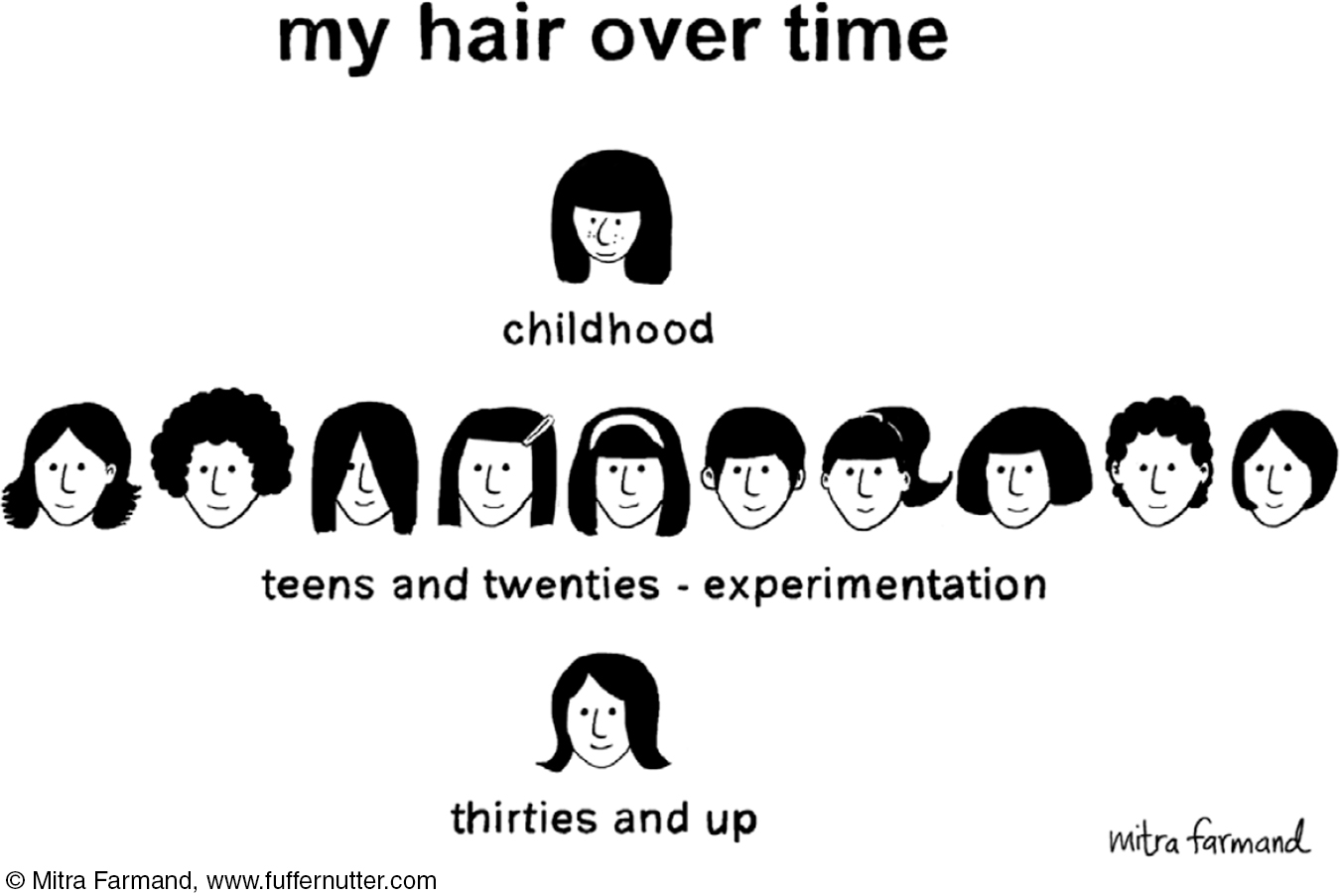39.1 Trait Theories

39-
trait a characteristic pattern of behavior or a disposition to feel and act, as assessed by self-
Rather than focusing on unconscious forces and thwarted growth opportunities, some researchers attempt to define personality in terms of stable and enduring behavior patterns, such as Lady Gaga’s openness to new experiences and her self-
Exploring Traits
Classifying people as one or another distinct personality type fails to capture their full individuality. We are each a unique complex of multiple traits. So how else could we describe our personalities? We might describe an apple by placing it along several trait dimensions—
What trait dimensions describe personality? If you had an upcoming blind date, what personality traits might give you an accurate sense of the person? Allport and his associate H. S. Odbert (1936) counted all the words in an unabridged dictionary with which one could describe people. There were almost 18,000! How, then, could psychologists condense the list to a manageable number of basic traits?
FACTOR ANALYSIS One technique is factor analysis, a statistical procedure that has been used to identify clusters (factors) of test items that tap basic components of a trait, such as intelligence (spatial ability or verbal skill). Imagine that people who describe themselves as outgoing also tend to say that they like excitement and practical jokes and dislike quiet reading. Such a statistically correlated cluster of behaviors reflects a basic factor, or trait—
British psychologists Hans Eysenck and Sybil Eysenck [EYE-
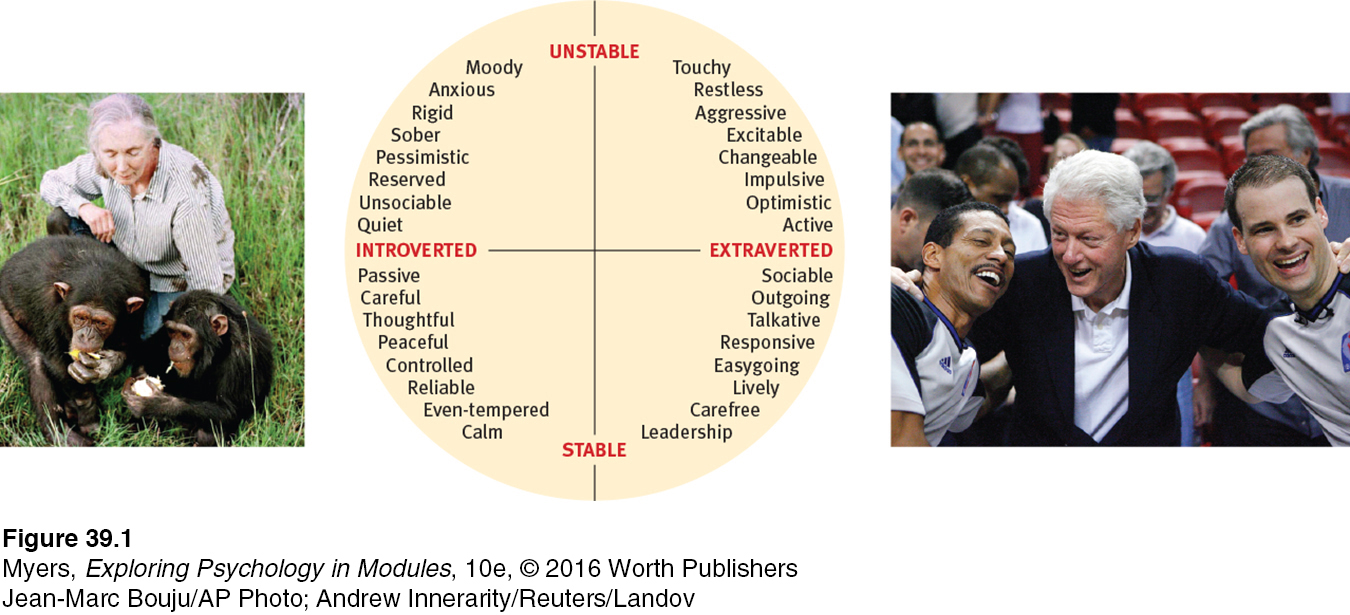

BIOLOGY AND PERSONALITY Brain-
Our biology influences our personality in other ways as well. As we know from twin and adoption studies, our genes have much to say about the temperament and behavioral style that help define our personality. Children’s shyness and inhibition may differ as an aspect of autonomic nervous system reactivity: Those with a reactive autonomic nervous system respond to stress with greater anxiety and inhibition (Kagan, 2010) (see Thinking Critically About: The Stigma of Introversion). The fearless, curious child may become the rock-
Personality differences among dogs (in energy, affection, reactivity, and curious intelligence) are as evident, and as consistently judged, as personality differences among humans (Gosling et al., 2003; Jones & Gosling, 2005). Monkeys, chimpanzees, orangutans, and even birds also have stable personalities (Weiss et al., 2006). Among the Great Tit (a European relative of the American chickadee), bold birds more quickly inspect new objects and explore trees (Groothuis & Carere, 2005; Verbeek et al., 1994). By selective breeding, researchers can produce bold or shy birds. Both have their place in natural history: In lean years, bold birds are more likely to find food; in abundant years, shy birds feed with less risk.
THINKING CRITICALLY ABOUT
The Stigma of Introversion
39-
Psychologists describe and measure personality, but they don’t advise which traits people should have. Society does this. Western cultures, for example, prize extraversion. In one study, 87 percent of people wanted to be more extraverted (Hudson & Roberts, 2014). Being introverted seems to imply that you don’t have the “right stuff” (Cain, 2012).
Just look at our superheroes. Extraverted Superman is bold and energetic. His introverted alter ego, Clark Kent, is mild-
TV shows also portray heartthrobs and examples of success as extraverts. Many consider Don Draper, the highly successful, attractive advertising executive in the show Mad Men to be a classic extravert. He is dominant and charismatic. Women clamor for his attention. His quiet secretary, Peggy Olson, gains respect and career advancement as the series progresses and she becomes more outspoken. Here again, extraversion equals success.
Why do we celebrate extraversion and belittle introversion? Many people may not understand what introversion really is. Introversion is not shyness. Introverted people seek low levels of stimulation from their environment because they’re sensitive. One classic study suggested that introverted people even have greater taste sensitivity. When given lemon juice, introverted people salivated more than extraverted people (Corcoran, 1964). Shy people, in contrast, remain quiet because they fear others will evaluate them negatively.

We also tend to believe that introversion acts as a barrier to success, yet introversion actually has many benefits. As supervisors, introverts show greater receptiveness when their employees voice their ideas, challenge existing norms, and take charge. Under these circumstances, introverted leaders outperform extraverted ones (Grant et al., 2011). One striking analysis of 35 studies showed no correlation between extraversion and sales performance (Barrick et al., 2001). Many introverts prosper. Consider the American presidency, which may offer the best example of the misperception that introversion hinders career success. The top-
So, introversion should not be considered a sign of weakness. Those who need a quiet break from a loud party are not social rejects nor are they incapable of great things. They simply need a less stimulating environment in order to thrive. It’s important for extraverts to understand that not everyone feels driven by high levels of stimulation. It’s not a crime to unwind.

RETRIEVE IT
Question
Which two primary dimensions did Hans Eysenck and Sybil Eysenck propose for describing personality variation?
Assessing Traits
39-
personality inventory a questionnaire (often with true-
If stable and enduring traits guide our actions, can we devise valid and reliable tests of them? Several trait-
 IMMERSIVE LEARNING Might astrology hold the secret to our personality traits? To consider this question, visit LaunchPad’s How Would You Know If Astrologers Can Describe People’s Personality?
IMMERSIVE LEARNING Might astrology hold the secret to our personality traits? To consider this question, visit LaunchPad’s How Would You Know If Astrologers Can Describe People’s Personality?
People have had fun spoofing the MMPI with their own mock items: “Weeping brings tears to my eyes,” “Frantic screams make me nervous,” and “I stay in the bathtub until I look like a raisin” (Frankel et al., 1983).
Minnesota Multiphasic Personality Inventory (MMPI) the most widely researched and clinically used of all personality tests. Originally developed to identify emotional disorders (still considered its most appropriate use), this test is now used for many other screening purposes.
empirically derived test a test (such as the MMPI) developed by testing a pool of items and then selecting those that discriminate between groups.
The classic personality inventory is the Minnesota Multiphasic Personality Inventory (MMPI). Although the MMPI was originally developed to identify emotional disorders, it also assesses people’s personality traits. One of its creators, Starke Hathaway (1960), compared his effort with that of Alfred Binet. Binet, the founder of modern intelligence testing, developed the first intelligence test by selecting items that identified children who would probably have trouble progressing normally in French schools. Like Binet’s items, the MMPI items were empirically derived: From a large pool of items, Hathaway and his colleagues selected those on which particular diagnostic groups differed. “Nothing in the newspaper interests me except the comics” may seem senseless, but it just so happened that depressed people were more likely to answer True. The researchers grouped the questions into 10 clinical scales, including scales that assess depressive tendencies, masculinity–
Whereas most projective tests are scored subjectively, personality inventories are scored objectively. (Software can administer and score these tests, and can also provide descriptions of people who previously responded similarly.) Objectivity does not, however, guarantee validity. Individuals taking the MMPI for employment purposes can give socially desirable answers to create a good impression. But in so doing they may also score high on a lie scale that assesses faking (as when people respond False to a universally true statement, such as “I get angry sometimes”). The objectivity of the MMPI has contributed to its popularity and to its translation into more than 100 languages.
The Big Five Factors
39-
Today’s trait researchers believe that simple trait factors, such as the Eysencks’ introversion–
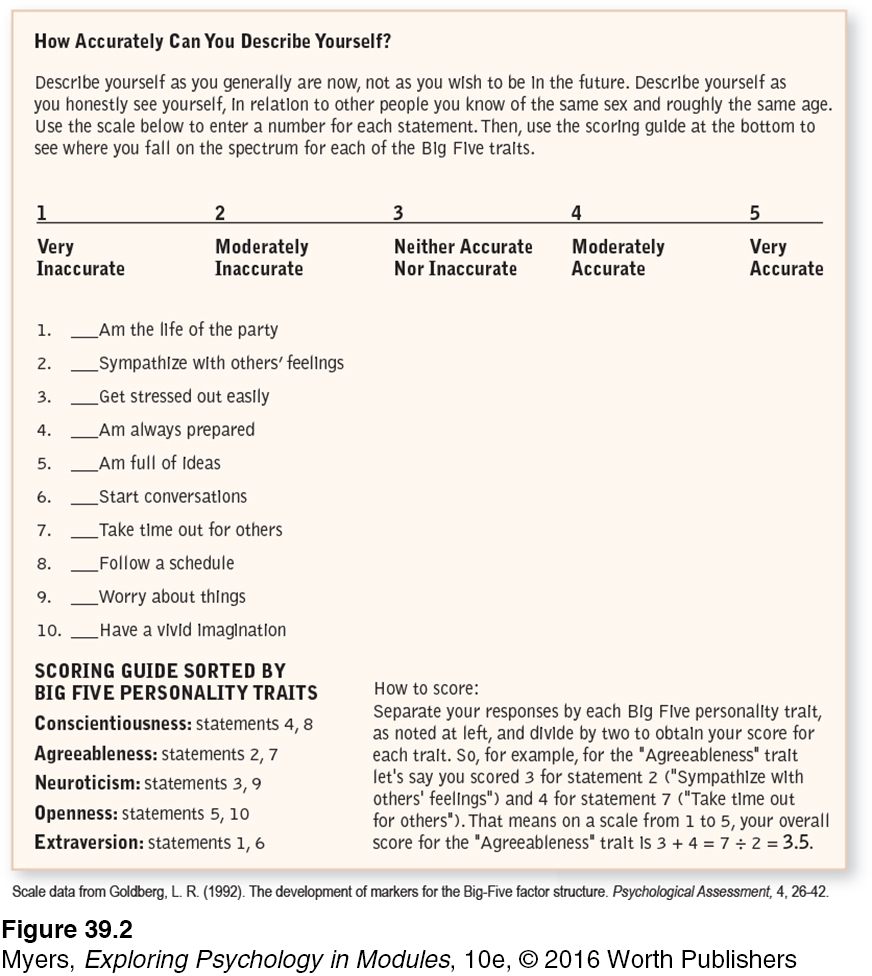
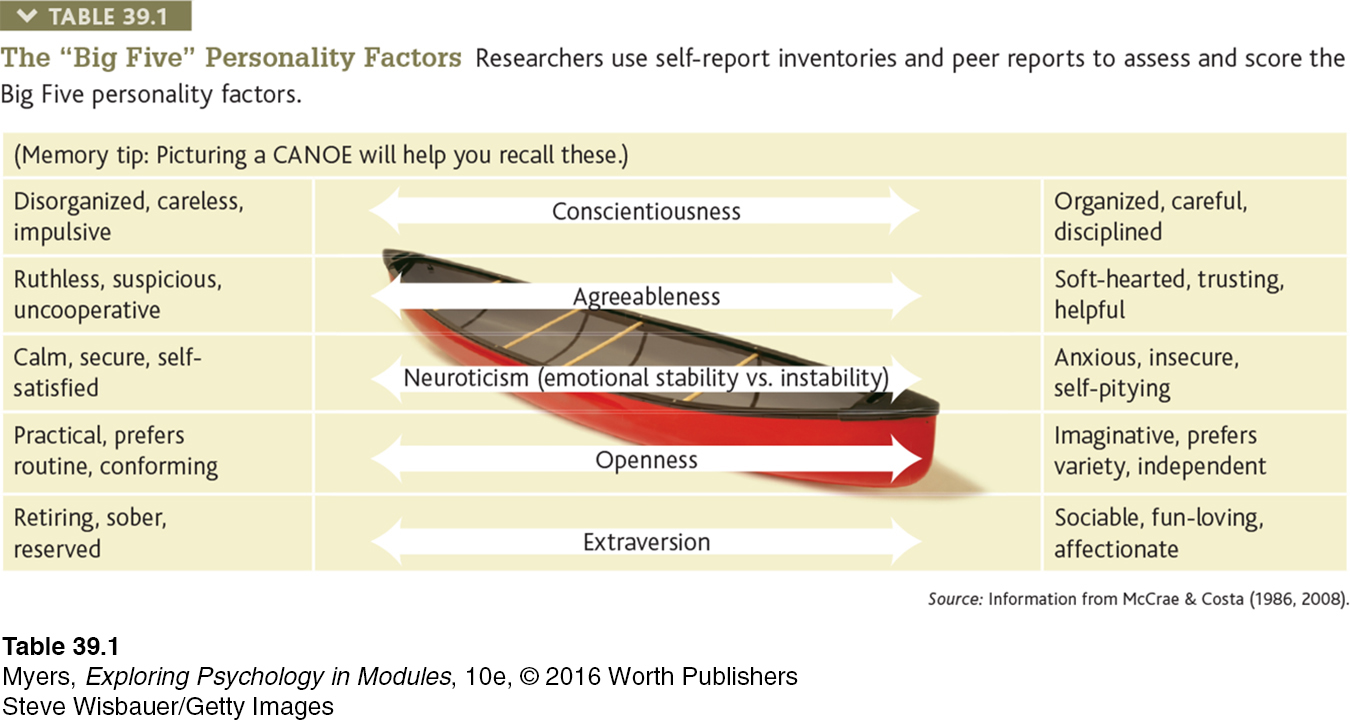
The Big Five is currently our best approximation of the basic trait dimensions. This “common currency for personality psychology” (Funder, 2001) has been the most active personality research topic since the early 1990s, as researchers have explored these questions and more:
How stable are the Big Five traits? One research team analyzed 1.25 million participants ages 10 to 65. They learned that personality continues to develop and change through late childhood and adolescence. Up to age 40, we show signs of a maturity principle: We become more conscientious and agreeable and less neurotic (emotionally unstable) (Bleidorn, 2015; Roberts et al., 2008). Great apes show similar personality maturation (Weiss & King, 2015). After age 40, our traits stabilize.
How heritable are these traits? Heritability (the extent to which individual differences are attributable to genes) generally runs about 40 percent for each dimension (Vukasovi´c & Bratko, 2015). Many genes, each having small effects, combine to influence our traits (McCrae et al., 2010).
How do these traits reflect differing brain structure? The size of different brain regions correlates with several Big Five traits (DeYoung et al., 2010; Grodin & White, 2015). For example, those who score high on conscientiousness tend to have a larger frontal lobe area that aids in planning and controlling behavior. Brain connections also influence the Big Five traits (Adelstein et al., 2011). People high in openness have brains that are wired to experience intense imagination, curiosity, and fantasy.
Have levels of these traits changed over time? Cultures change over time, which can influence shifts in personality. Within the United States and the Netherlands, extraversion and conscientiousness have increased (Mroczek & Spiro, 2003; Smits et al., 2011; Twenge, 2001).
How well do these traits apply to various cultures? The Big Five dimensions describe personality in various cultures reasonably well (Schmitt et al., 2007; Vazsonyi et al., 2015; Yamagata et al., 2006). “Features of personality traits are common to all human groups,” concluded Robert McCrae and 79 co-
researchers (2005) from their 50- culture study. Do the Big Five traits predict our actual behaviors? Yes. If people report being outgoing, conscientious, and agreeable, “they probably are telling the truth,” reports McCrae (2011). For example, our traits appear in our language patterns. In text messaging, extraversion predicts use of personal pronouns. Agreeableness predicts positive-
emotion words. Neuroticism (emotional instability) predicts negative- emotion words (Holtgraves, 2011). (In the next section, we will see that situations matter, too.)
 For an 8-
For an 8-
By exploring such questions, Big Five research has sustained trait psychology and renewed appreciation for the importance of personality. Traits matter.
RETRIEVE IT
Question
What are the Big Five personality factors, and why are they scientifically useful?
Evaluating Trait Theories
39-
Are our personality traits stable and enduring? Or does our behavior depend on where and with whom we find ourselves? In some ways, our personality seems stable. Cheerful, friendly children tend to become cheerful, friendly adults. At a recent college reunion, I [DM] was amazed to find that my jovial former classmates were still jovial, the shy ones still shy, the happy-
“There is as much difference between us and ourselves, as between us and others.”
Michel de Montaigne, Essays, 1588
THE PERSON-
Roughly speaking, the temporary, external influences on behavior are the focus of social psychology, and the enduring, inner influences are the focus of personality psychology. In actuality, behavior always depends on the interaction of persons with situations.
In considering research that has followed lives through time, some scholars (especially those who study infants) are impressed with personality change; others are struck by personality stability during adulthood. As FIGURE 39.3 illustrates, data from 152 long-
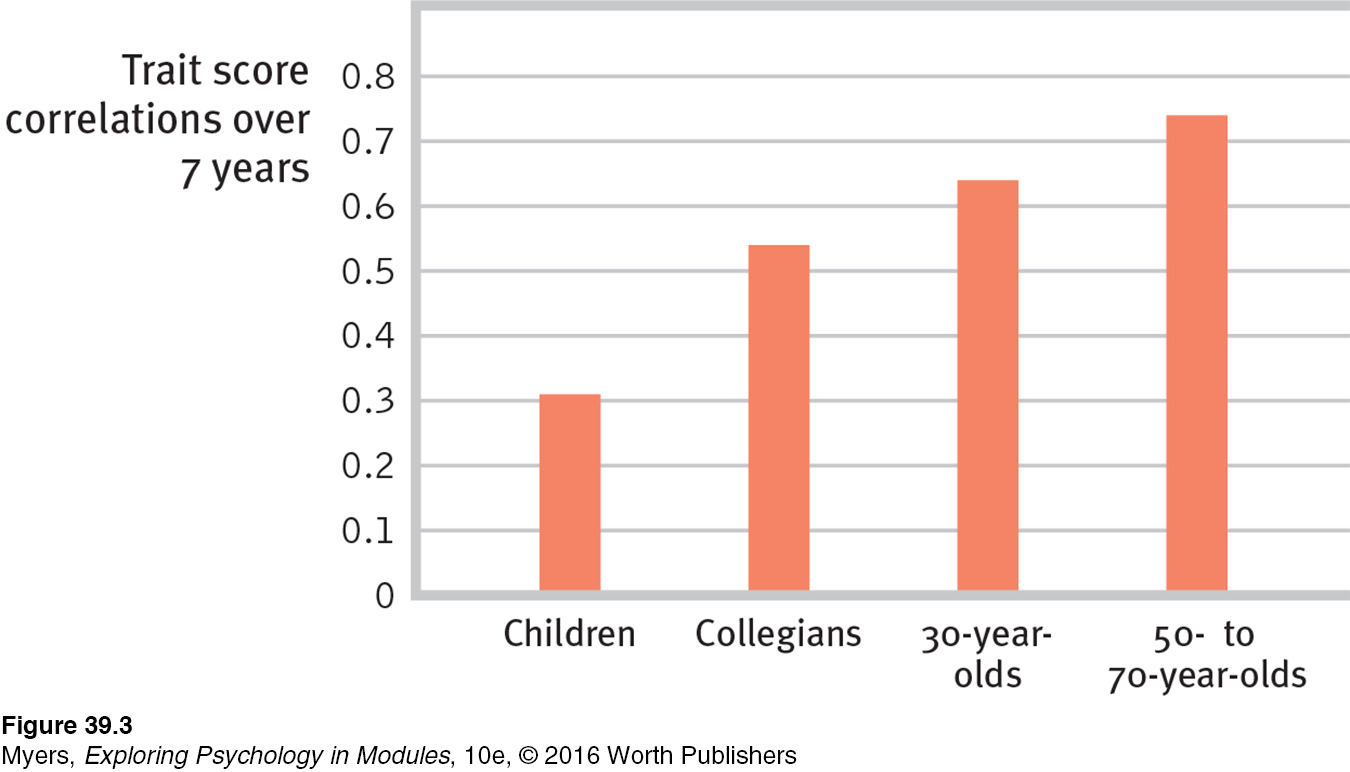
Change and consistency can co-
So most people—
Any of these tendencies, taken to an extreme, become maladaptive. Agreeableness ranges from cynical combativeness at its low extreme to gullible subservience at its high extreme. Conscientiousness ranges from irresponsible negligence to workaholic perfectionism (Widiger & Costa, 2012).
Although our personality traits may be both stable and potent, the consistency of our specific behaviors from one situation to the next is another matter. As Walter Mischel (1968, 2009) has pointed out, people do not act with predictable consistency. Mischel’s studies of college students’ conscientiousness revealed only a modest relationship between a student’s being conscientious on one occasion (say, showing up for class on time) and being similarly conscientious on another occasion (say, turning in assignments on time). If you’ve noticed how outgoing you are in some situations and how reserved you are in others, perhaps you’re not surprised.
This inconsistency in behaviors also makes personality test scores weak predictors of behaviors. People’s scores on an extraversion test, for example, do not neatly predict how sociable they actually will be on any given occasion. If we remember this, says Mischel, we will be more cautious about labeling and pigeonholing individuals. Years in advance, science can tell us the phase of the Moon for any given date. A day in advance, meteorologists can often predict the weather. But we are much further from being able to predict how you will feel and act tomorrow.
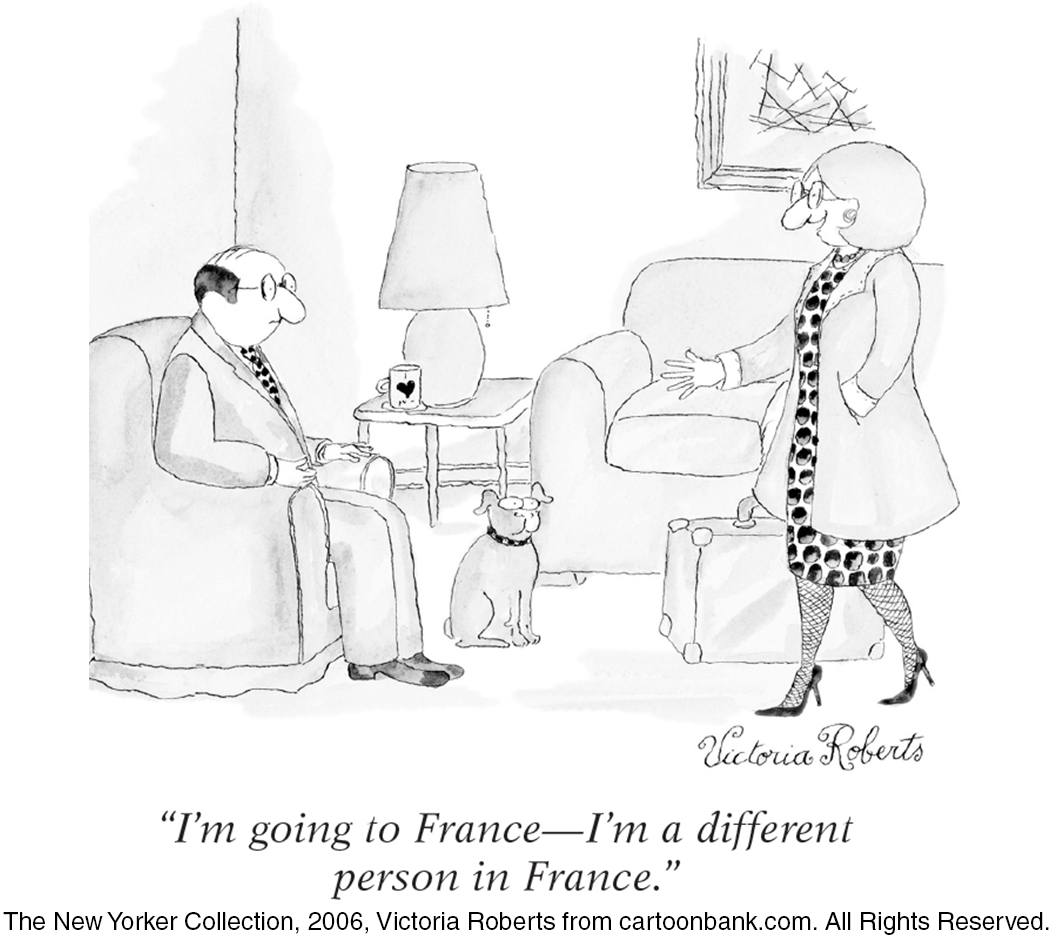
However, people’s average outgoingness, happiness, or carelessness over many situations is predictable (Epstein, 1983a,b). People who know someone well, therefore, generally agree when rating that person’s shyness or agreeableness (Jackson et al., 2015; Kenrick & Funder, 1988). The predictability of average behavior across many situations was again confirmed when researchers collected snippets of people’s daily experience via body-
music preferences. Your playlist says a lot about your personality. Classical, jazz, blues, and folk music lovers tend to be open to experience and verbally intelligent. Extraverts tend to prefer upbeat and energetic music. Country, pop, and religious music lovers tend to be cheerful, outgoing, and conscientious (Langmeyer et al., 2012; Rentfrow & Gosling, 2003, 2006).
online spaces. Is a personal website, social media profile, online avatar, or instant messaging account also a canvas for self-
expression? Or is it an opportunity for people to present themselves in false or misleading ways? It’s more the former (Back et al., 2010; Fong & Mar, 2015; Gosling et al., 2007). Viewers quickly gain important clues to the creator’s extraversion, conscientiousness, and openness to experience. written communications. If you have ever felt you could detect others’ personality from their writing voice, you are right!! (What a cool, exciting finding!!! . . . if you know what we’re saying.) People’s ratings of others’ personality based solely on their e-
mails, blogs, and Facebook posts correlate with actual personality scores on measures such as extraversion and neuroticism (Park et al., 2015; Pennebaker, 2011; Yarkoni, 2010). Extraverts, for example, use more adjectives.

In unfamiliar, formal situations—
To sum up, we can say that at any moment the immediate situation powerfully influences a person’s behavior. Social psychologists have learned that this is especially so when a “strong situation” makes clear demands (Cooper & Withey, 2009). We can better predict drivers’ behavior at traffic lights from knowing the color of the lights than from knowing the drivers’ personalities. Averaging our behavior across many occasions does, however, reveal distinct personality traits. Traits exist. We differ. And our differences matter.
RETRIEVE IT
Question
How well do personality test scores predict our behavior? Explain.
